Geometric shapes for children - features of study. Geometric figures for kids: games and educational benefits
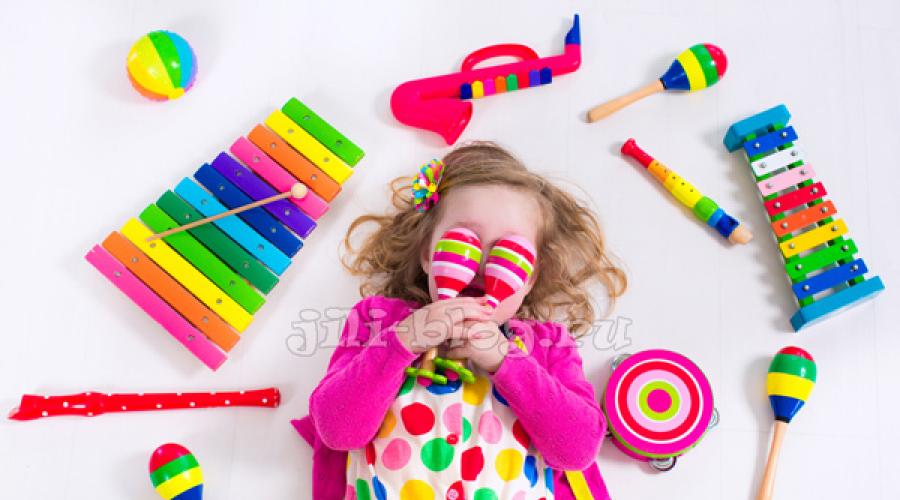
In today's article, I would like to tell about how easily and fascinating can study geometric shapes with the baby, and why in general early age Ship the child with geometry. What games will be interested in the baby from 1 year, and what materials you need for classes - about all this, read in the article. In addition, here you will find several useful materials For download.
Why study geometric shapes with baby?
- The study of geometric shapes is useful for common development Baby, expanding his knowledge about the world around. If you get acquainted a child with forms at an early age, in school he will have much easier.
Geometric forms are found everywhere, they can be seen in most items around us: the ball is round, the table is rectangular, etc. Analyzing the similarities of the surrounding items with geometric shapes, the child works remarkably by associative and spatial thinking.
On the ability to distinguish geometric figures, many interesting educational games are based. This design, games with, mosaic, mathematical tablet, etc. Therefore, the study of forms in such an early age will contribute to further successful development Child.
So, games for studying and consolidating knowledge about geometric figures :
1. Call geometric shapes always and everywhere
If you have any figure during games or reading books, you will definitely pay the baby's attention to it and call it ("Look, the ball looks like a circle, and a cube is on the square"). Even if it seems to you that the child is still unlikely to remember the names of the figures, all the same say them, and they will definitely be laid out in his head. You can do it already up to the year. At first, point only to the main figures (square, circle, triangle), then, when you understand that the baby learns them, start learning and other figures.
2. Play in geometric lotto
For first classes with the baby, it is better to use the lotto, where only 3-4 shapes. When the kid is well creating such a game, gradually complicate the task. Also useful for the first time all the figures on the game field make one color and size. In this case, the child will only be focused on one sign - the form, the other characteristics will not be distracting or suggesting him.
You can apply on the playing field as cards with the image of the figures and volumetric figures. Well, for this purpose is suitable dienesh blocks (Ozon., Koroboom.), Figures from a sorter, liner frame.
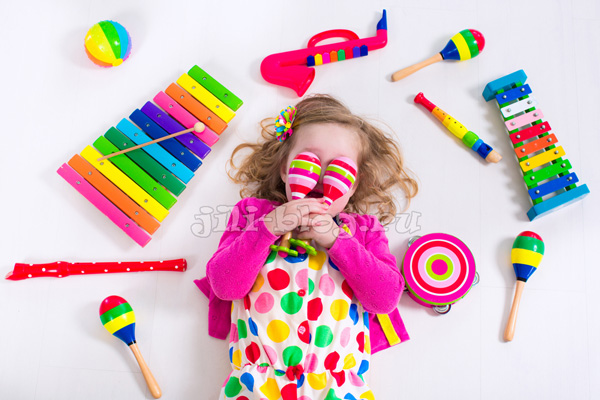
Well, the most non-slip option is to purchase ready lotto with geometric shapes.
3. Play with sorter
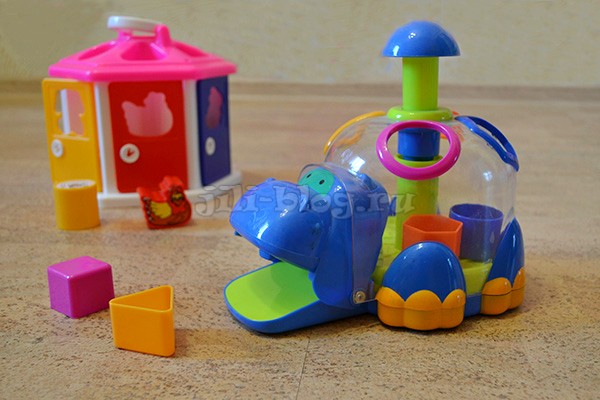
At about the age of 1, the child begins to notice that the figure chosen to them sorteors (Ozone, Labyrinth, My-Shop.) You can push away far from each hole. Therefore, during the game, it is necessary to emphasize this attention: "So, here we have a circle - it does not fit here, it does not fit here, but where is suitable?" At first, turn the figure at the right angle to the baby may be hard, but it is not scary, this is a matter of practice. The main thing, do not forget the fascinating process in time all the time to pronounce the names of the figures all the time, and the child will not remember them.
Important! When choosing a sorter, note that all major geometric shapes are presented there, not just hearts and crescents.
4. Play with the liner frame
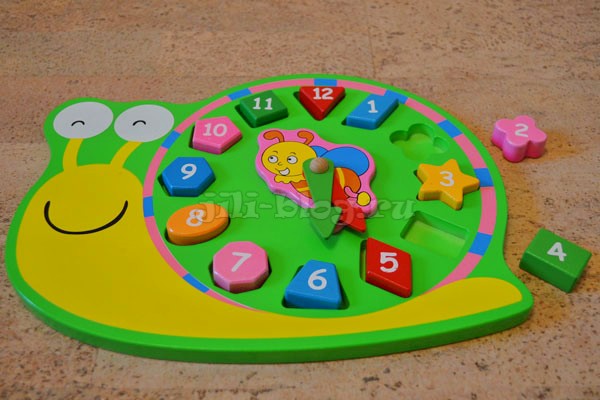
It will take such frame linerwhich presents all the main figures. In essence, the game is similar to the sorter.
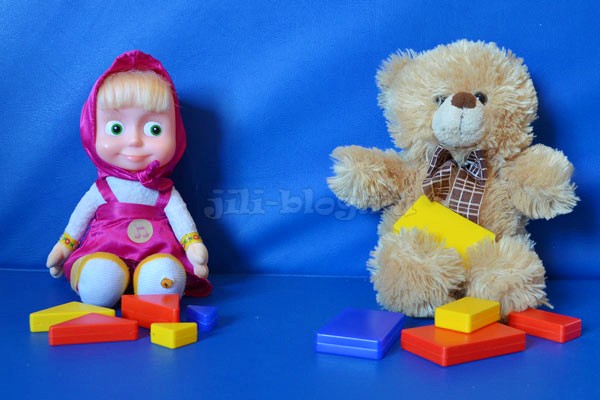
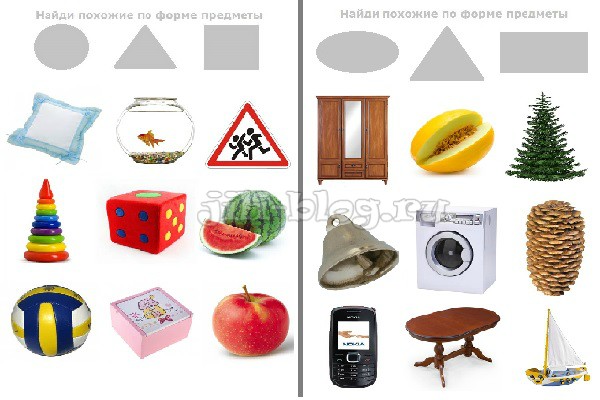
Here is one more interesting game for recognition of forms - "" ( Labyrinth, My-Shop.). Despite the fact that age on it is indicated for 3-5 years, it will be interested in a child of 2 years and even a little earlier.
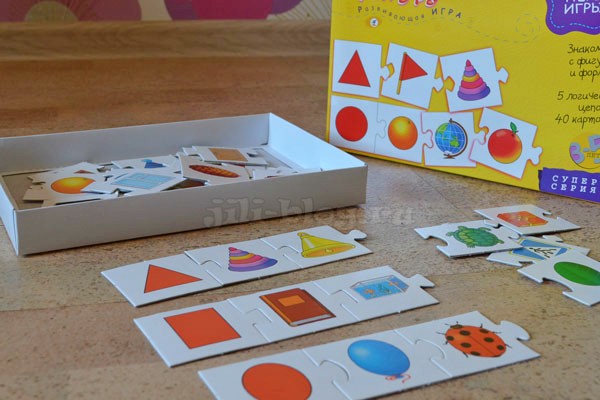
9. We teach forms on cards of Domana
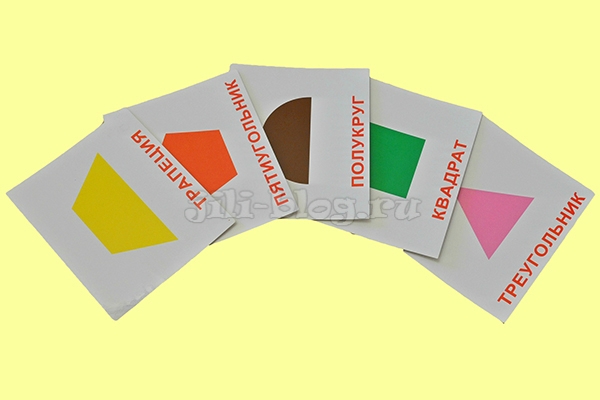
In fact, I believe that this method of studying forms is the most efficient. If you are engaged in, the child will remember all the figures very quickly, and you will spend my minimum effort. However, it should be noted that in order for the knowledge obtained by the Domana cards, the kid in the head, they need to be fixed through other games (see above). Otherwise, the child will quickly forget everything that you showed him. Therefore, I recommend to start looking at the House of Domana with geometric figures about aged 1 year, since at this time the baby becomes interesting to the kids, liner frames, drawing, appliqué, etc. And, having studied forms on pictures, he will be able to use the knowledge gained in these games. By the way, cards " Geometric figures"You can, and buy HERE.
You can read about our experience of studying figures on Domana cards.
10. Watch the developing cartoons
Well, of course, it will not prevent the viewing of cartoons on the topic "Geometric Figures", now there can be a lot of internet on the Internet. Here is some of them:
Instead of imprisonment
Very often, the process of learning the child with geometric figures (and not only figures) is perceived by parents exclusively as a permanent examination of the child, i.e. They show a child a couple of times, for example, a square, and in the future, learning comes down to the question "Tell me, what kind of figure?". This approach is extremely wrong. First, because like anyone, the child does not like too much when he is satisfied with the test of knowledge, and it only beat his hunt to do. Secondly, before asking a baby about something, he needs to explain it very many times and show!
Therefore, try to reduce check questions to a minimum. Just repeat and repeat the information studied, whether the names of the figures or something else. Do it during games and conversations with the baby. And the fact that the child learned everything, you will soon see without unnecessary checks.
Kuznetsova Tatiana
Didactic game « Geometric figures» for second junior Group .
purpose: To form in children 3-4 the ability to select geometric shapes in shape and color; Fasten title figs(Circle, Square, Triangle, Rectangle) and colors (red, blue, yellow, green); promote the development of shallow motility; Develop thinking.
Description: In children, 3-4 years old have difficulty distinguishing colors and geometric shapes. To make it easier for children to remember the names of the colors and geometric figures I made a didactic game« Geometric figures» .
The game Consists of two cards made on the photo paper format A4 and 36 figs(Circle, Square, Rectangle, Triangle) Four colors (red, yellow, blue, green, two figures of each color.
The child must decompose figures In accordance with the form and color. for example: The first line is depicted a circle and four colors, then the child must pick up the circles of red, yellow, green and blue flowers; second Stitch-depicted yellow and four figuresSo the child must pick up a circle, square, triangle and a yellow rectangle.
In the future, you can make more cards with other colors. For example, add-vite blue, pink, orange, purple colors.
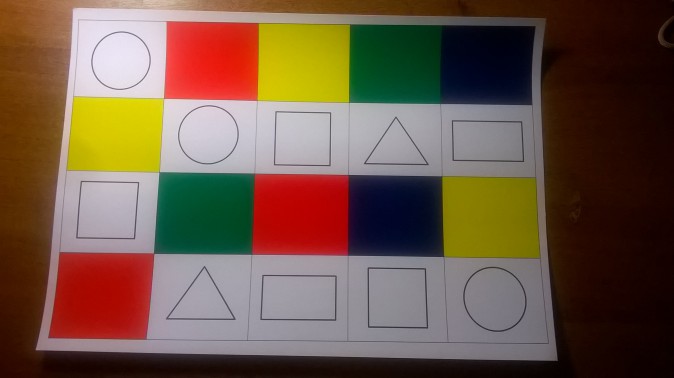
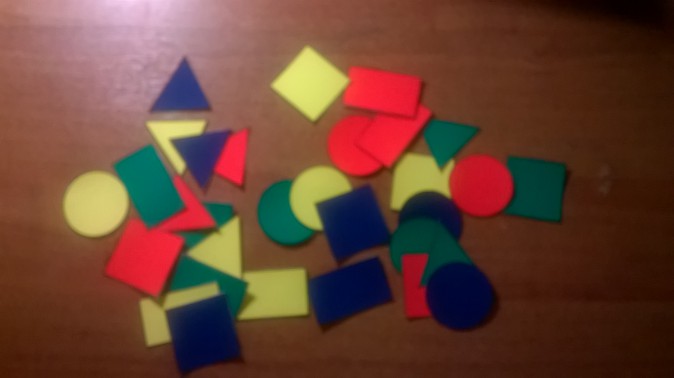
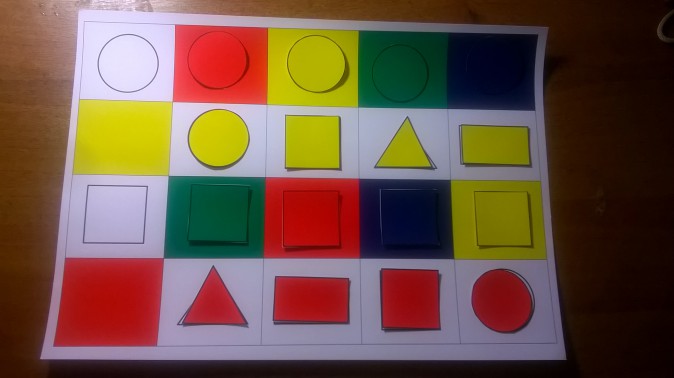
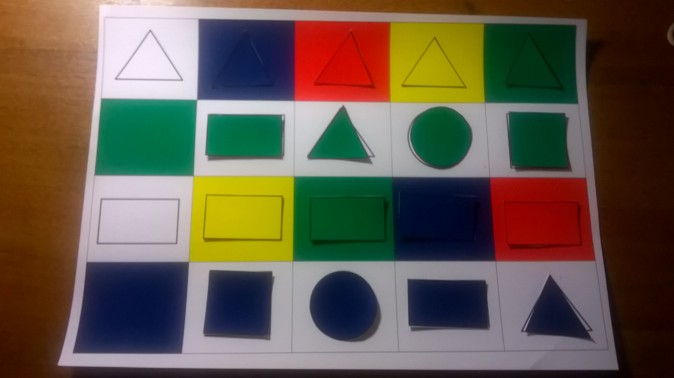
Publications on the topic:
Elementary mathematical representations "Geometric shapes" elementary-mathematical representations One of the most basic types.
Tasks: Secure knowledge of geometric figures, exercise in the compilation of parts of a whole geometric shape, develop visual perception,.
Node abstract for the younger group using an interactive board "Geometric Figures" Geometric figures. Purpose: Fasten the idea of \u200b\u200bgeometric shapes. Teach children classify geometric shapes in three.
Development of children from 3 years to 4 years. You are in the section "Children from 3 to 4 years old."
In this section, we will help you to learn and determine the level of development of your child, namely, what should be known and be able to make your child aged 3 to 4 years.
What should know and be able to be able to 3 year old child.
This article is intended for your familiarization and gives exemplary rates for the degree of formation. mental processes Your child at this age. You can check its potential opportunities in different areas Knowledge, find out what areas of knowledge your child succeeds, and in which additional attention is required and time.
In this section "Children from 3 to 4 years old" we have collected all the material published on our website, which will help you and your child to do, prepare for the next, more in-depth stage of classes.
Materials for your classes you can use at home in kindergarten or in primary classes.
Mathematics
1. The child should be able to count to three and show the appropriate amount of fingers on hand.Manuals for classes:
2. The child should be able to possess the concepts: one - a lot, large - small, high - low, etc.
3. The child should know the main colors (red, yellow, green, blue, white, black).
4. The child should know the main geometric shapes (circle, square, triangle).
5. The child should be able to compare items in magnitude, color, shape. Be able to compare the number of items.
6. The child should be able to select a pair to the subject with a specified sign.
1.
2.
3.
4.
5.
6.
7.
8.
9.
10.
11.
12.
13.
14.
15.
16.
17.
18.
19.
20.
21.
22.
Logical thinking
- development of thinking, memory, attention
A child aged 3 to 4 years old should be able to:
1. The child should be able to add a cut picture from 2-4 parts.Manuals for classes:
2. The child should be able to find and explain inconsistencies in the drawings.
3. The child should be able to find an extra object and explain why he made such a choice.
4. The child should be able to find similarities and differences between objects.
5. The child should be able to memorize 2-3 pictures.
6. The child should be able to memorize 3-4 words that adult repeated several times.
7. The child should be able to memorize and repeat the movements that adult showed 1-2 times,
8. The child should be able to remember any detail or sign of the subject.
9. The child must be able to do not be distracted for 5 minutes.
10. The child must find paired items. Be able to choose from a group of items.
11. The child should be able to pay attention to the properties and signs of objects, find similarities and differences between objects.
1.
2.
3.
4.
5.
6.
7.
8.
9.
10.
11.
12.
13.
14.
15.
Detergery
A child aged 3 to 4 years old should be able to:
1. The child should be able to not only visually perceive images, but also to describe what they saw.Manuals for classes:
2. The child easily forms simple sentences, gradually moves to a complex (out of 5-6 words).
3. The child should be able to separate items by groups: furniture, dishes, clothes, etc.
4. The child should be able to call one sign of each subject.
5. The child should know the names of the basic actions of people and animals (lies, sits, runs, etc.)
6. The child should be able to repeat the adults of the rhymes and songs.
7. The child must know his name and surname.
8. The child should be able to manage the power of the voice, speak loudly - quietly.
Methods for children representing geometric shapes, a lot in the modern market. Below are the main of them, as well as games that develop a child.
Nowadays, the child's early development give great importance. Crowe begin to teach almost from the maternity hospital. There are many games, books, video and audio materials that help children quickly master such simple - at first glance - themes, as letters, numbers, shapes, colors. Particularly popular cards showing geometric shapes for kids. This allowance is clearly concise. It allows the child to quickly and easily master the necessary knowledge.
When to start learning geometric shapes?
In general, you can get acquainted with forms from the first months. No bad if you are in gaming formwithout making a baby, you will show it pictures or toys, clearly pronounce the name of the figure (circle, square, etc.).
Thus, by two years, the child must know the three forms well:
- triangle;
- a circle;
- square.
To three years in this list must be added:
- oval;
- rhombus;
- rectangle.
By the way, learning geometric forms much attention It is paid in Mary Montessori technique. In its materials there are several games that help the child quickly learn to determine the forms of items. We will talk about them further.
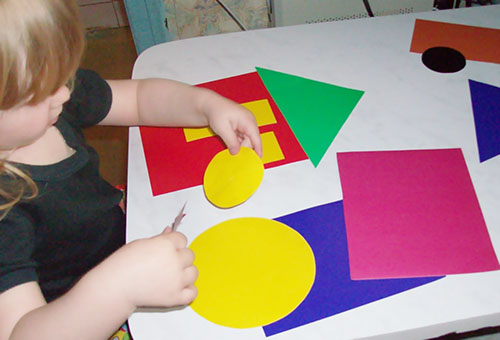
Why study geometric figures kid?
About benefit early Development It has already been said quite a few. Exactly active learning The kid in the period from birth to three years to form his creativity and fluency thinking, infevering and love for knowledge, the ability to quickly absorb the information.
The study of forms is necessary for some other reasons.
- The whole world around consists of figures (circle - wheel of the machine, plate, sun; square - window, chair seat, etc.).
- Preparing for school - the earlier the kid will win simple knowledge, the easier it will be to study at school.
- Studying forms will allow the baby to play those games that are not available to children who do not know what a circle is, square, etc.
- Studying geometric shapes, the child expands its horizons, trains the brain, increases the vocabulary.
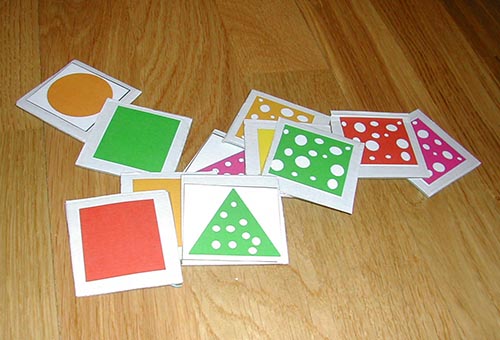
5 Rules for Training Geometric Figures
It is worth remembering that all the information that seems to us is elementary, for children is new and often incomprehensible. With geometric shapes, this rule works almost always. Therefore, if a child confuses a circle with a square and does not want to be corrected, be patient and do not scold the crumb for the blunders.
For a faster and easy learning assimilation, Follow the simple advice.
- Specify the baby on geometric shapes in everyday life. Showing Chad the book, tell me that it is rectangular, demonstrating a saucer, give him a "circle" definition.
- Try to receive feedback. Inquire the baby, to which category there is a house, table, pillow. Look at the learning video and ask the child to tell what he saw.
- Use toys of correct geometric shapes. Buy croches round and triangular molds, cubes, ball.
- Play those in games where knowledge of the names of the figures is required (see below).
- Watch videos and cartoons telling about forms (for example, "Baby Einstein").
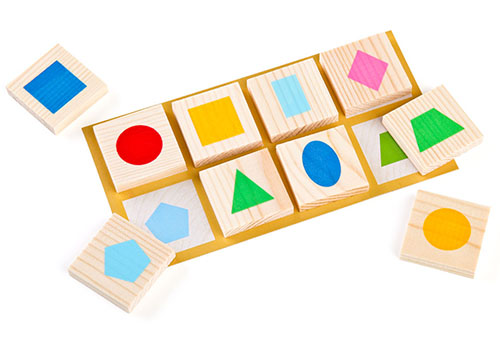
Games "Geometric Figures" for children
Sorter
This is one of the first developing kid toys, allowing you to learn about the properties. different figures. The essence of the sorter is that for a certain opening, you need to pick up a toy of the corresponding form (ball, cube and others). The child begins to understand what.
Such a toy not only teaches Karapuz to quickly distinguish the figures of different geometric shapebut also trains small motor Fingers, and also develops logical thinking.
Montessori Games
Maria Montessori, as already mentioned above, attached great importance to geometric pieces in the developing kid games. In its methodology there are several ways to introduce a child with geometry in a game form. For example:
- Put the figures in an opaque package or bag. Let the baby bearing alternately on one toy and, without getting it, determines which form it is.
- For an older child, you can come up with this task: tell me the word-definition, for example, "ride". The kid should call forms that have this property.
- You can offer Cross to name all forms with or without corners, with or without edges.
- Creative version of the game with figures. Ask a child to dream and say what the circle is similar to, a square, a triangle.
In the Montessori technique there is a special device, called "Frames and Inserts". This is a kind of analogue of the sorter, which we talked above.
Pictures and stencils
If you like to draw your child, use it in order to teach it to distinguish the shapes. Draw a house together. Expand all the details: Square windows, the roof is a triangle, etc.
You can also offer a child stencils. They can be cut independently from thick paper or purchase ready.
Running one or another figure, the baby will learn to draw them ("fading a hand"), and your comments (this is a circle, this is a triangle) will help you to remember their names faster.
Domana cards
The Domana method is very popular among parents interested in the early development of his child. It implies the use of visual cards for better assimilation of the knowledge gained. Domana has a separate set of cards dedicated to geometric pieces. It can be bought or downloaded on the Internet (you can also find a video about this technique).
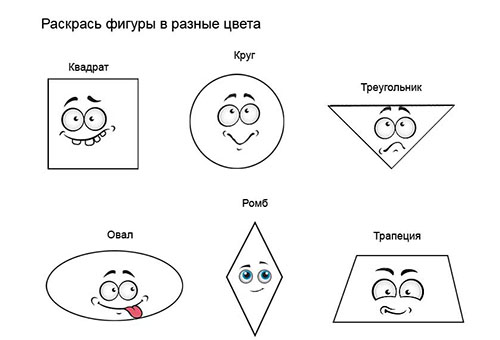
Literature and didactic material
Below are the most popular and effective techniques and materials for familiarizing children with geometric shapes.
- "School of Seven Dwarfs"
In the cycle of books for early development of children "School of Seven Dwarfs" there are two ones on forms: "Square and a circle" (for children from birth and up to year), "Form. Color "(for children from 1 year to 2 years). The books are large and clearly represented the main figures.
- Geometric figures. Soft mosaic
Very comfortable and bright way to introduce a child with forms. Mosaic made of safe soft material. The kid will be interested to consider her details and collect pictures of them.
- Coloring
There are a lot of such teachers' bookkends in the modern market. You can select "smart coloring. Smeshariki »With the favorite children with the characters from the cartoon of the same name.
- Stickers
Reusable stickers will also be very useful during the period of learning the child "geometry for the smallest". Such stickers can be glued anywhere! In the bathroom, in the children's room, in the kitchen. Suggest the Cross Game: In the environment it is necessary to find objects of a particular type.
Cartoons about geometric figures
Conclusion
Learning and acquaintance of a child with geometric figures is not only important, but also very interesting! Show fantasy, come up with your games and tasks for Chad, show interesting videosAnd he will answer you love and gratitude.
Modern producers of goods for children and children's psychologists offer to engage in developing and learning a child almost immediately after his birth. By what methods do it - solve only parents, but some basic concepts should be explained outside the main program. For kids, no less than the colors and names of the main household items are important. How to correctly introduce a child with circles and ovals?
Why do you need geometry to preschoolers?
The concept of shape and size helps to perceive the world and objects compare them among themselves. You, without thinking, say, describing some unusual piece of furniture, that it looks like two rectangles with rounded edges. Now imagine how difficult it is to describe and compare some objects, not knowing the names and concepts. simple forms. That is why learn geometric shapes for kids is useful as early as possible. Already by 2-3 years, the child should know at least a circle, square, rectangle, triangle, rhombus. Gradually, you can add more complex figures.
We go to search for figures!
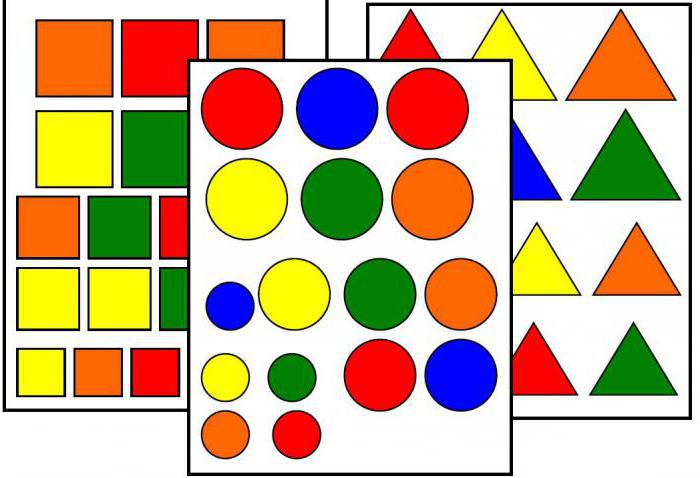 The easiest way to teach the child during the game is. Try to interest the baby, serve new Material In the original game form. For the smallest even need to organize classes, you can learn between the case. Tell us that the cup is round, and the book is rectangular. Visual manualrevealing the concept of "geometric shapes", for kids will be the most ordinary toys. Compare cubes and balls together, complicate the task, adding dishes or fruits for playing the store. Older children can be taken on long time, asking to find in the room as many circles or triangles. Help me to show all the fantasy and explain that the figures can "hide" on the fabric or wallpaper in the form of a picture, be a whole subject or part of it.
The easiest way to teach the child during the game is. Try to interest the baby, serve new Material In the original game form. For the smallest even need to organize classes, you can learn between the case. Tell us that the cup is round, and the book is rectangular. Visual manualrevealing the concept of "geometric shapes", for kids will be the most ordinary toys. Compare cubes and balls together, complicate the task, adding dishes or fruits for playing the store. Older children can be taken on long time, asking to find in the room as many circles or triangles. Help me to show all the fantasy and explain that the figures can "hide" on the fabric or wallpaper in the form of a picture, be a whole subject or part of it.
Entertaining geometry
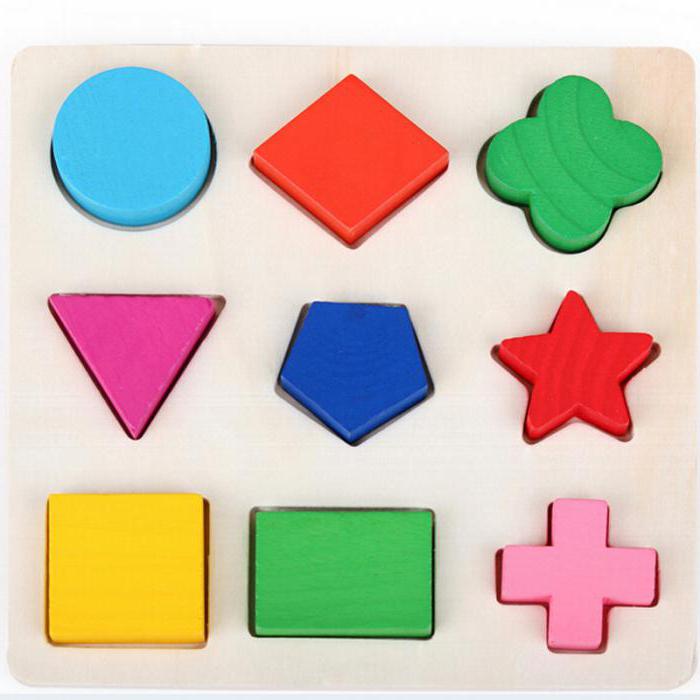 To learn 5 geometric shapes is much easier, if they draw them yourself. Offer baby creative task, take a sheet of paper and paint, pencils and markers and depicting a circle, rectangle, square, triangle and rhombus. A more interesting version of this game - Mom paints a geometric shape, and the child telesses some elements, turning the form in an object or an animal. You can also draw a rectangle on a sheet of paper and hang in a prominent place. Of course, someone from your guests will be surprised to decorate the interior, but you can always answer: "We teach the geometric shapes with kids." The next day, draw a circle and hang it next to the rectangle. And then suggest compare figures with each other. Gradually add other forms and be sure to give a few minutes a day to such learning.
To learn 5 geometric shapes is much easier, if they draw them yourself. Offer baby creative task, take a sheet of paper and paint, pencils and markers and depicting a circle, rectangle, square, triangle and rhombus. A more interesting version of this game - Mom paints a geometric shape, and the child telesses some elements, turning the form in an object or an animal. You can also draw a rectangle on a sheet of paper and hang in a prominent place. Of course, someone from your guests will be surprised to decorate the interior, but you can always answer: "We teach the geometric shapes with kids." The next day, draw a circle and hang it next to the rectangle. And then suggest compare figures with each other. Gradually add other forms and be sure to give a few minutes a day to such learning.
Useful toys for learning figures
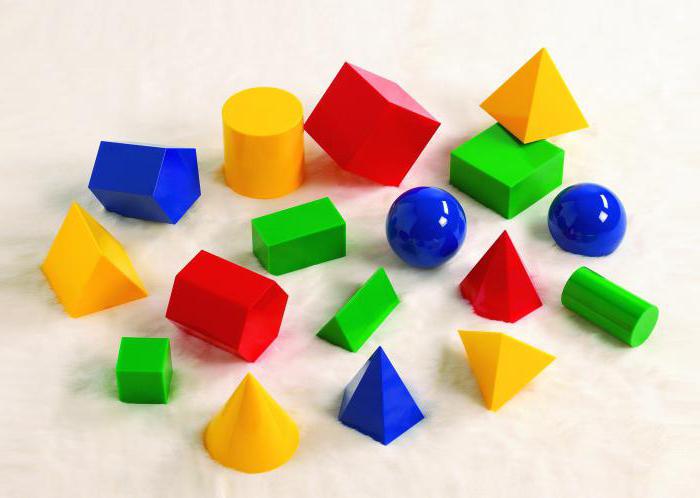 A variety of games and toys will help to explore the basics of geometry. The easiest option: Purchase ready-made cards with the image of the figures. Usually such sets are focused on learning shape and color. Cards can be a lot, the figures are repeated on them, but differ in size and shade. Play with such desktop game It is possible for hours. Ask to collect everything same forms, then decompose them in size. Then mix the cards and offer to find all the figures of the same size or color. If desired, such a game can be done with your own hands. Help in learning geometry is capable and special children's lotto. If you wish, it is not difficult to find such a game dedicated to Figures. And yet sorters remain the most popular geometric toys. This is usually some kind of base (capacity, frame) having slots different shapes. Color geometric shapes are inserted into the holes. The task of the child is to choose the corresponding slot based on each small subject. Sorters are decorated in different stylesBut choosing the easiest - geometric, you get the opportunity to learn the names of the figures during their placement at the base. Wooden or cardboard frames with liners made on the principle of sorter can help in learning forms. It is also useful to watch special learning cartoons about geometric shapes for kids. Combine all the proposed learning options, and then your child does not have problems with geometry.
A variety of games and toys will help to explore the basics of geometry. The easiest option: Purchase ready-made cards with the image of the figures. Usually such sets are focused on learning shape and color. Cards can be a lot, the figures are repeated on them, but differ in size and shade. Play with such desktop game It is possible for hours. Ask to collect everything same forms, then decompose them in size. Then mix the cards and offer to find all the figures of the same size or color. If desired, such a game can be done with your own hands. Help in learning geometry is capable and special children's lotto. If you wish, it is not difficult to find such a game dedicated to Figures. And yet sorters remain the most popular geometric toys. This is usually some kind of base (capacity, frame) having slots different shapes. Color geometric shapes are inserted into the holes. The task of the child is to choose the corresponding slot based on each small subject. Sorters are decorated in different stylesBut choosing the easiest - geometric, you get the opportunity to learn the names of the figures during their placement at the base. Wooden or cardboard frames with liners made on the principle of sorter can help in learning forms. It is also useful to watch special learning cartoons about geometric shapes for kids. Combine all the proposed learning options, and then your child does not have problems with geometry.